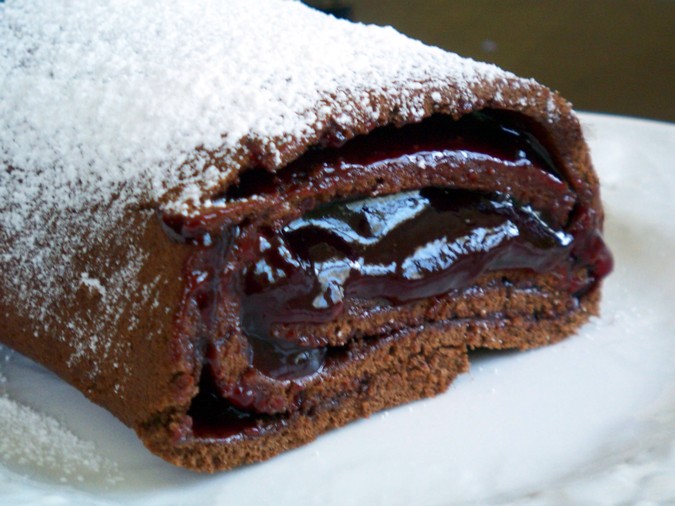
A velvety lemon cake to have for tea–inspired by Edith Wharton’s “The House of Mirth”.
 This is my entry for the lovely blog event co-hosted by Simona of Briciole and Lisa of Champaign Taste, for which participants prepare a dish that has a connection to a literary work.
This is my entry for the lovely blog event co-hosted by Simona of Briciole and Lisa of Champaign Taste, for which participants prepare a dish that has a connection to a literary work.
Edith Wharton is one of my favorite American writers, I enjoyed all of her novels–and her ghost stories too.
The cake I made is inspired by the tea and cake shared by Lily Bart and her friend Lawrence Selden as told in the early pages of The House of Mirth (1905).
This cake–with its moist texture and pleasant lemony flavor–goes really well with a nice cup of tea, so it might very well be the one mentioned in the book. And I do have a green teapot as well.
here is the excerpt from chapter 1 of “The House of Mirth”:
He paused a moment. “Come up and see,” he suggested. “I can give you a cup of tea in no time–and you won’t meet any bores.”
Her colour deepened–she still had the art of blushing at the right time–but she took the suggestion as lightly as it was made.
“Why not? It’s too tempting–I’ll take the risk,” she declared.
“Oh, I’m not dangerous,” he said in the same key. In truth, he had never liked her as well as at that moment. He knew she had accepted without afterthought: he could never be a factor in her calculations, and there was a surprise, a refreshment almost, in the spontaneity of her consent.
On the threshold he paused a moment, feeling for his latchkey.
“There’s no one here; but I have a servant who is supposed to come in the mornings, and it’s just possible he may have put out the tea-things and provided some cake.”
He ushered her into a slip of a hall hung with old prints. She noticed the letters and notes heaped on the table among his gloves and sticks; then she found herself in a small library, dark but cheerful, with its walls of books, a pleasantly faded Turkey rug, a littered desk and, as he had foretold, a tea-tray on a low table near the window. A breeze had sprung up, swaying inward the muslin curtains, and bringing a fresh scent of mignonette and petunias from the flower-box on the balcony.
Lily sank with a sigh into one of the shabby leather chairs.
“How delicious to have a place like this all to one’s self! What a miserable thing it is to be a woman.” She leaned back in a luxury of discontent.
Selden was rummaging in a cupboard for the cake.
“Even women,” he said, “have been known to enjoy the privileges of a flat.”
“Oh, governesses–or widows. But not girls–not poor, miserable, marriageable girls!”
“I even know a girl who lives in a flat.”
She sat up in surprise. “You do?”
“I do,” he assured her, emerging from the cupboard with the sought-for cake.
“Oh, I know–you mean Gerty Farish.” She smiled a little unkindly. “But I said MARRIAGEABLE–and besides, she has a horrid little place, and no maid, and such queer things to eat. Her cook
does the washing and the food tastes of soap. I should hate that, you know.”
“You shouldn’t dine with her on wash-days,” said Selden, cutting the cake.
They both laughed, and he knelt by the table to light the lamp under the kettle, while she measured out the tea into a little tea-pot of green glaze. As he watched her hand, polished as a bit of old ivory, with its slender pink nails, and the sapphire bracelet slipping over her wrist, he was struck with the irony of suggesting to her such a life as his cousin Gertrude Farish had chosen. She was so evidently the victim of the civilization which had produced her, that the links of her bracelet seemed like manacles chaining her to her fate.
And now for the cake:
From the original recipe by Jane Cunningham Croly
In: “Jennie June’s American Cookery Book”, 1870–USA
Ingredients
1 cup (227 g) butter
3 cups (600 g) sugar
4 eggs, divided
1 cup (245 g) milk
1 large (organic) lemon–juice and grated zest
4 cups (454 g) flour, sifted
Icing: 1 small egg white, beaten till light and foamy
2 cups confectioners’ sugar
lemon juice
Preheat oven to 325°F (170°C), grease and flour two 9.1 x 5.4 inch (13.6 x 23.2 cm) loaf pans
Cream the butter until light and fluffy, then gradually add the sugar. Add the 4 yolks, one at a time, then the lemon juice (strained) and the grated zest. Gently add the flour, little by little through a strainer, and then the milk in a fine stream, still beating at high speed. The mixture should be light and creamy. Finally fold in the egg whites, beaten until stiff and glossy, taking care not to deflate the mixture.
Divide the batter into the prepared pans and bake at 325°F (170°C) for 45 minutes or more, until a toothpick comes out clean from the center of each cake.
Let the cakes cool in the pans placed on racks for 5 minutes, then take them out of the pans and let them finish cooling on the racks. Ice the cakes once they are perfectly cold.
Icing: mix the confectioners’ sugar with a little egg white and 1/2 tbsp lemon juice to a spreading consistency and cover the top and sides of each loaf.
Notes: This cake does not contain any leavening, and to be light the batter must be worked well to incorporate as much air as possible. It must be baked at no more than 325°F , otherwise it will brown too fast on top and still be raw in the middle.
The recipe can be halved.

 As the guest host of the 50th edition of Sugar High Fridays, the blog event dedicated to sweets founded by Jennifer of The Domestic Goddess I proposed Rolled Cakes as a theme. My own take on this is from the old classic Italian cook book La Scienza in Cucina e l’ Arte di Mangiar Bene—published in 1891—written by Pellegrino Artusi. It is a sponge cake flavored with bittersweet chocolate, to which I added a simple filling of seedless raspberry jam and a sprinkle of confectioners’ sugar on top. The final result is a pleasant dessert in which flavors and textures combine perfectly, and that is also quick and easy to assemble.
As the guest host of the 50th edition of Sugar High Fridays, the blog event dedicated to sweets founded by Jennifer of The Domestic Goddess I proposed Rolled Cakes as a theme. My own take on this is from the old classic Italian cook book La Scienza in Cucina e l’ Arte di Mangiar Bene—published in 1891—written by Pellegrino Artusi. It is a sponge cake flavored with bittersweet chocolate, to which I added a simple filling of seedless raspberry jam and a sprinkle of confectioners’ sugar on top. The final result is a pleasant dessert in which flavors and textures combine perfectly, and that is also quick and easy to assemble.















